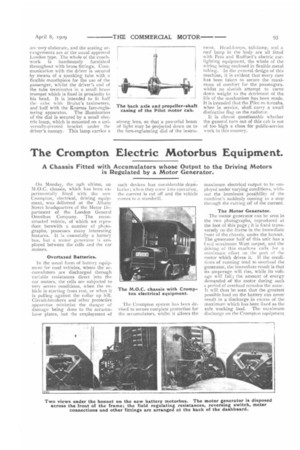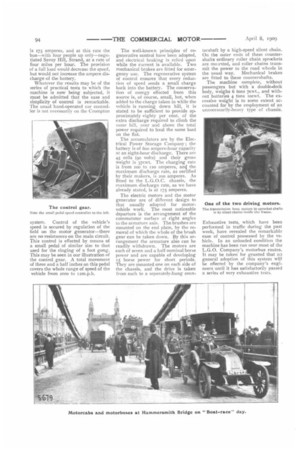The Crompton Electric Motorbus Equipment.
Page 3

Page 4

If you've noticed an error in this article please click here to report it so we can fix it.
A Chassis Fitted with Accumulators whose Output to the Driving Motors is Regulated by a Motor Generator.
On Monday, the 29th ultimo, an M.O.C. chassis, which has been experimentally fitted with the new Crompton, electrical, driving equipment, was delivered at the Albany Street headquarters of the Motor Department of the London General Omnibus Company. The reconstructed vehicle, of which we reproduce herewith a number of photographs, possesses many interesting features. It is essentially a battery bus, but a motor generator is employed between the cells and the car motors.
Overtaxed Batteries.
ln the usual form of battery equipment for road vehicles, where the accumulators are discharged through variable resistances direct into the car motors, the cells are subjected to very severe conditions, when the vehicle is starting from rest, or when it is pulling against the collar up hill. Circuit-breakers and other protective apparatus minimise the danger of damage being done to the accumulator plates, but the employment of such devices has considerable drawbacks; when they come into operation, the current is cut off and the vehicle comes to a standstill.
The Crompton system has been devised to secure complete protection for the accumulators, whilst it allows the maximum electrical output to be employed under varying conditions, without the imminent possibility of the machine's suddenly coming to a stop through the cutting off of the current.
The Motor Generator.
The motor generator can be seen in the two photographs, reproduced at the foot of this page; it is fixed transversely on the frame in the immediate front of the chassis, under the bonnet. Thegenerator half of this unit has a lised maximum Watt output, and the driving of this machine calls for a maximum effort on the part of rhe motor which drives it. If the conditions of running tend to overload the generator, the immediate result is that its amperage will rise, while its voltage will fall ; the amount of energy demanded of the motor during such a period of overload remains the same. It will thus be seen that the greatest possible load on the battery can never result in a discharge in excess of the maximum which has been fixed as the safe working load. The maximum discharge on the Crompton equipment
is 175 amperes, and at this rate the bus—with four people up only—negotiated Savoy Hill, Strand, at a rate of four miles per hour. The provision of a full load would decrease the speed, but would not increase the ampere discharge of the battery.
Whatever the results may be of the series of practical tests to which the machine is now being subjected, it must be admitted that the ease and simplicity of control is remarkable. The usual hand-operated car controller is not necessarily on the Crompton system. Control of the vehicle's speed is secured by regulation of the field on the motor generator—there are no resistances on the main circuit. This control is effected by means of a small pedal of similar size to that used for the ringing of a foot gong. This may be seen in our illustration of the control gear. A total movement of three and a half inches on this pedal covers the whole range of speed of the vehicle from zero to 'm.p.h.
The well-known principles of regenerative control have been adopted, and electrical braking is relied upon while the current is available. Two mechanical brakes are fitted for emergency use. The regenerative system of control ensures that every reduction of speed sends a small charge back into the battery. The conservation of energy effected from this source is, of course, small, but, when added to the charge taken in while the vehicle is running down hill, it is stated to be sufficient to provide approximately eighty per cent, of the extra discharge required to climb the same hill, over and above the total power required to haul the same load on the flat.
The accumulators are by the Electrical Power Storage Company ; the battery is of floe ampere-hour capacity at an eight-hour discharge. There are 45 cells (90 volts) and their gross weight is 37cwt. The charging rate is from ea° to 120 amperes, anc) the maximum discharge rate, as certified by their makers, is 200 amperes. As fitted to the L.G.O.C. chassis, the maximum discharge rate, as we have already stated, is at 175 amperes.
The electric motors and the motor generator are of different design to that usually adopted for motorvehicle work. The most noticeable departure is the arrangement of the commutator surface at right angles to the armature axis. The brushes are mounted on the end plate, by the removal of which the whole of the brush gear can be taken down. By this arrangement the armature also can be readily withdrawn. The motors are each of seven and a half nominal horse power and are capable of developing 15 horse power for short periods. They are mounted one on each side of the chassis, and the drive is taken from each to a separately-hung coun
tershaft by a high-speed silent chain. On the outer ends of these countershafts ordinary roller chain sprockets are moInted, and roller chains transmit the power to the road wheels in the usual way. Mechanical brakes are fitted to these countershafts.
The machine complete, without passengers but with a double-deck body, weighs 6 tons 7cwt., and without batteries 4 tons tocwt. The excessive weight is to some extent accounted for by the employment of an unnecessarily-heavy type of chassis.
Exhaustive tests, which have been performed in traffic during the past week, have revealed the remarkable ease of control possessed by the vehicle. In an unloaded condition the machine has been run over most of the L.G.O. Company's motorbus routes. It may be taken for granted that 113 general adoption of this system will be effected by the company's engineers until it has satisfactorily passed a series of very exhaustive tests.


















